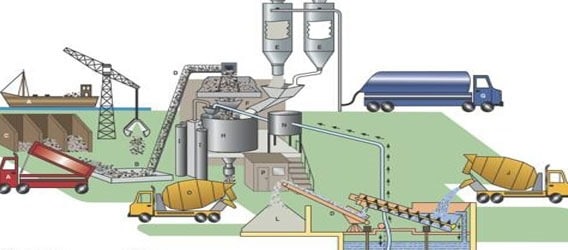CONCRETE MIX DESIGN AND ITS ADVANTAGES
Concrete mix design is of two types:
1. Nominal concrete mix
2. Designed concrete mix
Nominal concrete mixes are those specified by standard codes for common construction works. These mix takes into consideration the margin for quality control, material quality and workmanship in concrete construction.
M10, M15, M20 are the commonly used nominal mixes used in construction. For higher grade of concrete, i.e. M25 and above, it is advised to have designed mix concrete.
Designed mix concrete suggests proportions of cement, sand, aggregates and water (and sometimes admixtures) based on actual material quality, degree of quality control, quality of materials and their moisture content for given concrete compressive strength required for the project. Designed mix concrete are carried out in laboratory and based on various tests and revisions in mix designs, the final mix proportions are suggested.
The concrete mix can be designed from M10 to various grades of concrete such as M50, M80, M100 etc for various workability requirements from no slump to 150mm slump values. These grades of concrete can be achieved by variations in the mix proportions and laboratory tests to ascertain it.
Sometimes admixtures are also required to enhance some properties of concrete such as workability, setting time etc. These admixtures also need to be considered during concrete mix design calculations for its optimum use. Their overdose can affect the properties of concrete and can cause harm to strength and durability.

Concrete mix design is the method of proportioning of ingredients of concrete to enhance its properties during plastic stage as well as during hardened stage, as well as to find economical mix proportions.
Properties desired from concrete in plastic stage: –
• Workability – Suitable workability for proper placement of concrete in structural member.
• Cohesiveness – better cohesiveness between cement and aggregates to prevent segregation of concrete.• Initial set retardation – to control the initial setting time of concrete based on requirements.
Properties desired from concrete in hardened stage:-
• Strength – Strength of concrete is the main objective of the concrete mix design.
• Imperviousness – Better mix proportions to improve imperviousness for protection of reinforcement form corrosion and enhanced durability of concrete.
• Durability – To increase the durability of concrete.
Advantages of Concrete Mix Design:
Concrete mix design is economically proportioning of concrete ingredients for better strength and durability based on construction site. While the nominal concrete mix may have higher amount of cement, when it is designed mix, the cement requirement may be low for the same grade of concrete for a given site. The proportions resulting from concrete mix design are tested for their strength with the help of compressive strength test on concrete cubes and cylinders.
The concrete mix design proves to provide better quality economically.
Following are the advantages of concrete mix designs:
1. Good quality concrete as per requirements – this means the concrete will have required strength, workability, impermeability, durability, density and homogeneity.
2. Nominal mix concrete may suggest more cement than other materials, and concrete mix designs gives the accurate quantity of cement consumption. Thus it is an economical solution for large projects.
It is possible to save up to 15% of cement for M20 grade of concrete with the help of concrete mix design. In fact higher the grade of concrete more are the savings. Lower cement content also results in lower heat of hydration and hence reduces shrinkage cracks.
3. Best use of available materials:
The nominal mix of concrete does not consider the quality of local construction materials. The concrete mix design is based on the quality of available materials locally. Thus it is also an economical solution to reduce the transportation cost of materials from long distance.
4. Desired Concrete Properties:
The designed mix concrete will have desired concrete properties based on project or construction requirements. Requirements such as durability, strength, setting times, workability etc. can be controlled with the type of construction with concrete mix design.
Other requirements such as early de-shuttering, pumpability, flexural strength, lightweight concrete can also be controlled
No comments:
Post a Comment